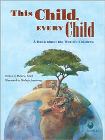By David J. Smith, Kids Can Press, $18.95, 36 pages
 “Children are not equally spread out across the world. Some countries have a low percentage of children while others have a high percentage. Of the 30 countries with the lowest percentage of children, 27 are in Europe. Of the 30 countries with the highest percentage of children, 25 are in Africa.”
“Children are not equally spread out across the world. Some countries have a low percentage of children while others have a high percentage. Of the 30 countries with the lowest percentage of children, 27 are in Europe. Of the 30 countries with the highest percentage of children, 25 are in Africa.”
This Child, Every Child is a superb example of what printed books can’t do and shouldn’t be trying to do in the digital age. That’s not to say there’s anything wrong with the message of this particular book — what could possibly be wrong about books that “inform children about the world and inspire them to be better global citizens,” as this series from Kids Can Press states? Nothing, except if said books not only fail to inform or inspire, but actually do damage by making information incredibly dull.
It makes absolutely no sense these days to produce a children’s book full of paragraphs of percentages, large numbers, and country names without, at the very least, accompanying visual representation to break up the monotony. There is also no reason why a book about the world’s children should not be illustrated with, at the very least, photography of those children and where they live, rather than murky, generic, acrylic artwork.
This Child, Every Child was created with the support of ONEXONE, a non-profit Canadian foundation committed to supporting, preserving, and improving the lives of children around the world. Its money would have been better spent by taking a page from their interactive website and creating an ebook or video that uses readily available technology to make the diverse realities of the world’s children immediate and exciting to their media-sophisticated intended audience, not an exercise in how to create a pie chart in your head.
Reviewed by Heather Shaw
